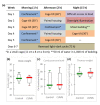Impact of a Model Used to Simulate Chronic Socio-Environmental Stressors Encountered during Spaceflight on Murine Intestinal Microbiota
- PMID: 33114008
- PMCID: PMC7672645
- DOI: 10.3390/ijms21217863
Impact of a Model Used to Simulate Chronic Socio-Environmental Stressors Encountered during Spaceflight on Murine Intestinal Microbiota
Abstract
During deep-space travels, crewmembers face various physical and psychosocial stressors that could alter gut microbiota composition. Since it is well known that intestinal dysbiosis is involved in the onset or exacerbation of several disorders, the aim of this study was to evaluate changes in intestinal microbiota in a murine model used to mimic chronic psychosocial stressors encountered during a long-term space mission. We demonstrate that 3 weeks of exposure to this model (called CUMS for Chronic Unpredictable Mild Stress) induce significant change in intracaecal β-diversity characterized by an important increase of the Firmicutes/Bacteroidetes ratio. These alterations are associated with a decrease of Porphyromonadaceae, particularly of the genus Barnesiella, a major member of gut microbiota in mice and humans where it is described as having protective properties. These results raise the question of the impact of stress-induced decrease of beneficial taxa, support recent data deduced from in-flight experimentations and other ground-based models, and emphasize the critical need for further studies exploring the impact of spaceflight on intestinal microbiota in order to propose strategies to countermeasure spaceflight-associated dysbiosis and its consequences on health.
Keywords: Barnesiella; chronic unpredictable mild stress; gut microbiota; spaceflight.
Conflict of interest statement
The authors declare no conflict of interest.
Figures



References
MeSH terms
Grants and funding
LinkOut - more resources
Full Text Sources
Medical

